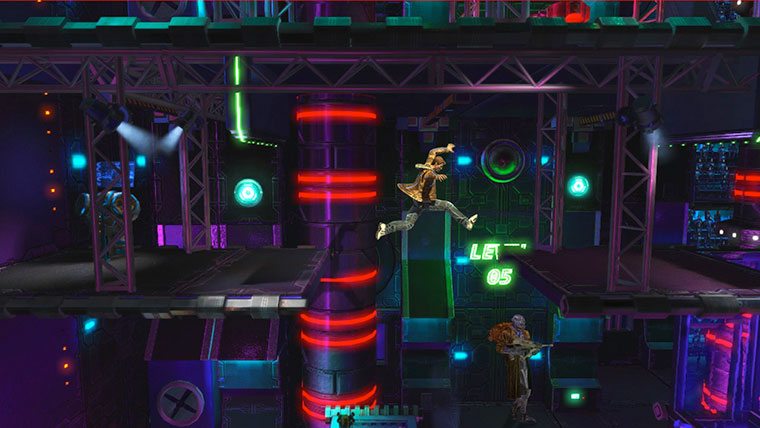In Flashback, you play as Conrad B. Hart, a GBI (Galaxia Bureau of Investigation) agent who begins the game without his memories, after being shot down in the Titan Jungle by a spaceship piloted by some pretty funky looking purple guys in trenchcoats – the games main enemies, Replicators.
Flashback opens by shooting itself in the foot and never looks back
The games opening stage is a real shot in the foot. You are tasked firstly with finding the teleporter belonging to another downed pilot you come across in the jungle, named Bolton – easy enough, as the tutorial stage shows you how to go about shooting, using the games molecular glasses to see notable objects (a nifty feature), and finding your way about. Then you have to collect 7 grenada fruits for a teleport belt to jump into the New Washington stage.
Sounds confusing? To anyone who hasn’t played the original, the convoluted storyline eventually makes sense, as Conrad discovers the sinister plot at works whilst resorting his identity, by finding capsule backups he stored prior to losing his memory found throughout the game world.
The gameplay on the other hand, suffers from that second onwards. The mundane task of finding those fruits is painful, and the game is not bug-free either. Checkpoints frequently end up taking Conrad very far back into the levels, although forgivingly, the game remembers which enemies you’ve taken care of.
The level design can be frustrating at times too, although the mini-map can usually solve any problems with navigation.
Jet bikes, aliens, and telportation are kick-ass, right?
It’s bittersweet when some moments, like the introduction to the Earth stage, complete with a great jet bike ride, show a graphically enticing, wonderfully stylistic, and captivating platformer/action game. This is running on the Unreal engine at a pseudo 2D perspective, and like Shadow Complex, it can look gorgeous at times, for an indie title – but you then get dragged back into the world of slightly choppy textures, plain bad game design, and misjudged checkpointing after every little sprint of greatness.
The story arc, as with the original, is a very good concept, and the whole story is a great, inspiring idea, which is marred by tacky dialogue, and the god-awful exclamations of “Awesome-sauce!” and “Let’s play!” from Conrad as he uses health stations, which, frequently, don’t respond to the pressing of the X button. Just great when you’re being shot at.
Boss fights can be entertaining; certainly, the final boss is a memorable fight, but many earlier bosses are uninspired, constricted, and fiddly affairs that leave a memory of cursing with little satisfaction when you finally take the bad guy down.
The story of this not-so-great remake is the most recommendable thing about it; it’s not an outright bad game, it does have stretches of fun, and the cutscenes, presented in a mixture of Manga-style black and white 2D animations, and 3D in game animations, really shine when they’re in play. You do, despite sometimes awfully thought out dialogue (not quite Just Cause 2, but not that far away), get a sense of empathy for Conrad if you’re new to his story, and to those gamers who played the Sega Mega Drive original, it’s a familiar story with some voice acting and cool cutscenes.
It’s only a memory
The whole title wraps up abruptly, and you’ll never have a reason to start it up again unless you really want to get the full gamerscore reward here.
The original game is included here, but for reasons I may never understand, the developers saw fit to chuck it into the actual 3D title scene, in a CRT cabinet. It looks cool, but well, playing anything on it is a bit tacky.
This whole game had potential to be a great remake, a spiritual successor, and so much more, but ultimately, fans of the original will want their memories back, and new players will want to forget it all together.











Published: Aug 24, 2013 10:54 pm